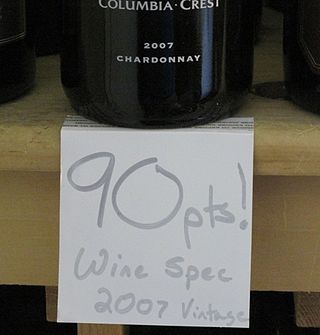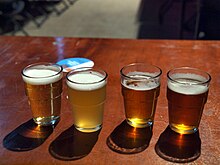
Beer is one of the oldest alcoholic drinks in the world, the most widely consumed, and the third most popular drink after water and tea. Beer is produced by the brewing and fermentation of starches from cereal grains—most commonly malted barley, although wheat, maize (corn), rice, and oats are also used. The fermentation of the starch sugars in the wort produces ethanol and carbonation in the beer. Most modern beer is brewed with hops, which add bitterness and other flavours and act as a natural preservative and stabilising agent. Other flavouring agents, such as gruit, herbs, or fruits, may be included or used instead of hops. In commercial brewing, natural carbonation is often replaced with forced carbonation.

Draught beer, also spelt draft, is beer served from a cask or keg rather than from a bottle or can. Draught beer served from a pressurised keg is also known as keg beer.

Pale ale is a golden to amber coloured beer style brewed with pale malt. The term first appeared in England around 1703 for beers made from malts dried with high-carbon coke, which resulted in a lighter colour than other beers popular at that time. Different brewing practices and hop quantities have resulted in a range of tastes and strengths within the pale ale family.

Ginger ale is a carbonated soft drink flavoured with ginger. It is consumed on its own or used as a mixer, often with spirit-based drinks. There are two main types of ginger ale. The golden style is credited to the Irish doctor Thomas Joseph Cantrell. The dry style, a paler drink with a much milder ginger flavour, was created by Canadian John McLaughlin.

A sommelier, or wine steward, is a trained and knowledgeable wine professional, normally working in fine restaurants, who specializes in all aspects of wine service as well as wine and food pairing. The role of the sommelier in fine dining today is much more specialized and informed than that of a wine waiter. Sommeliers Australia states that the role is strategically on par with that of the chef de cuisine.

A barrel or cask is a hollow cylindrical container with a bulging center, longer than it is wide. They are traditionally made of wooden staves and bound by wooden or metal hoops. The word vat is often used for large containers for liquids, usually alcoholic beverages; a small barrel or cask is known as a keg.

Beer has been brewed in England for thousands of years. As a beer brewing country, it is known for top fermented cask beer which finishes maturing in the cellar of the pub rather than at the brewery and is served with only natural carbonation.
Wine accessories are things that may be used in the storage or serving of wine. Wine accessories include many items such as wine glasses, corkscrews, and wine racks.

Beer styles differentiate and categorise beers by colour, flavour, strength, ingredients, production method, recipe, history, or origin.
Blinded wine tasting is wine tasting undertaken in circumstances in which the tasters are kept unaware of the wines' identities. The blind approach is routine for wine professionals who wish to ensure impartiality in the judgment of the quality of wine during wine competitions or in the evaluation of a sommelier for professional certification. More recently wine scientists have used blinded tastings to explore the objective parameters of the human olfactory system as they apply to the ability of wine drinkers to identify and characterize the extraordinary variety of compounds that contribute to a wine’s aroma. Similarly, economists testing hypotheses relating to the wine market have used the technique in their research. Some blinded trials among wine consumers have indicated that people can find nothing in a wine's aroma or taste to distinguish between ordinary and pricey brands. Academic research on blinded wine tastings have also cast doubt on the ability of professional tasters to judge wines consistently.

Beer glassware comprise vessels made of glass, designed or commonly used for serving and drinking beer. Styles of glassware vary in accord with national or regional traditions; legal or customary requirements regarding serving measures and fill lines; such practicalities as breakage avoidance in washing, stacking or storage; commercial promotion by breweries; artistic or cultural expression in folk art or as novelty items or usage in drinking games; or to complement, to enhance, or to otherwise affect a particular type of beer's temperature, appearance and aroma, as in the case of its head. Drinking vessels intended for beer are made from a variety of materials other than glass, including pottery, pewter, and wood.

Lees are deposits of dead yeast or residual yeast and other particles that precipitate, or are carried by the action of "fining", to the bottom of a vat of wine after fermentation and aging. The same while brewing beer at a brewery is known as trub – the same from secondary fermentation of wine and beer are the lees or equally, as to beer only, dregs. This material is the source for most commercial tartaric acid, which is used in cooking and in organic chemistry.

The use of wine tasting descriptors allows the taster to qualitatively relate the aromas and flavors that the taster experiences and can be used in assessing the overall quality of wine. Wine writers differentiate wine tasters from casual enthusiasts; tasters attempt to give an objective description of the wine's taste, casual enthusiasts appreciate wine but pause their examination sooner than tasters. The primary source of a person's ability to taste wine is derived from their olfactory senses. A taster's own personal experiences play a significant role in conceptualizing what they are tasting and attaching a description to that perception. The individual nature of tasting means that descriptors may be perceived differently among various tasters.

An alcoholic beverage is a drink that contains ethanol, a type of alcohol and is produced by fermentation of grains, fruits, or other sources of sugar. The consumption of alcoholic drinks, often referred to as "drinking", plays an important social role in many cultures. Alcoholic drinks are typically divided into three classes—beers, wines, and spirits—and typically their alcohol content is between 3% and 50%.

Wine tasting is the sensory examination and evaluation of wine. While the practice of wine tasting is as ancient as its production, a more formalized methodology has slowly become established from the 14th century onward. Modern, professional wine tasters use a constantly evolving specialized terminology which is used to describe the range of perceived flavors, aromas and general characteristics of a wine. More informal, recreational tasting may use similar terminology, usually involving a much less analytical process for a more general, personal appreciation.

The aging of wine is potentially able to improve the quality of wine. This distinguishes wine from most other consumable goods. While wine is perishable and capable of deteriorating, complex chemical reactions involving a wine's sugars, acids and phenolic compounds can alter the aroma, color, mouthfeel and taste of the wine in a way that may be more pleasing to the taster. The ability of a wine to age is influenced by many factors including grape variety, vintage, viticultural practices, wine region and winemaking style. The condition that the wine is kept in after bottling can also influence how well a wine ages and may require significant time and financial investment. The quality of an aged wine varies significantly bottle-by-bottle, depending on the conditions under which it was stored, and the condition of the bottle and cork, and thus it is said that rather than good old vintages, there are good old bottles. There is a significant mystique around the aging of wine, as its chemistry was not understood for a long time, and old wines are often sold for extraordinary prices. However, the vast majority of wine is not aged, and even wine that is aged is rarely aged for long; it is estimated that 90% of wine is meant to be consumed within a year of production, and 99% of wine within 5 years.

The aromas of wine are more diverse than its flavours. The human tongue is limited to the primary tastes perceived by taste receptors on the tongue – sourness, bitterness, saltiness, sweetness and savouriness. The wide array of fruit, earthy, leathery, floral, herbal, mineral, and woodsy flavour present in wine are derived from aroma notes sensed by the olfactory bulb. In wine tasting, wine is sometimes smelled before taking a sip in order to identify some components of the wine that may be present. Different terms are used to describe what is being smelled. The most basic term is aroma which generally refers to a "pleasant" smell as opposed to odour which refers to an unpleasant smell or possible wine fault. The term aroma may be further distinguished from bouquet which generally refers to the smells that arise from the chemical reactions of fermentation and aging of the wine.

A wine rating is a score assigned by one or more wine critics to a wine tasted as a summary of that critic's evaluation of that wine. A wine rating is therefore a subjective quality score, typically of a numerical nature, given to a specific bottle of wine. In most cases, wine ratings are set by a single wine critic, but in some cases a rating is derived by input from several critics tasting the same wine at the same time. A number of different scales for wine ratings are in use. Also, the practices used to arrive at the rating can vary. Over the last couple of decades, the 50–100 scale introduced by Robert M. Parker, Jr. has become commonly used. This or numerically similar scales are used by publications such as Wine Enthusiast, Wine Spectator, and Wine Advocate. Other publications or critics, such as Jancis Robinson and Michael Broadbent, may use a 0–20 scale, or a 0–5 scale either with or without half-star steps.

Ale is a type of beer originating in medieval England, brewed using a warm fermentation method. Historically, the term referred to a drink brewed without hops.
Flavor lexicons or flavour lexicons are used by professional taste testers to develop and detail the sensory perception experienced from food. The lexicon is a word bank developed by professional taste testers in order to identify an objective, nuanced and cross-cultural word bank for food.
















